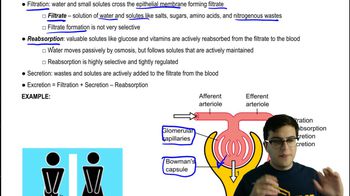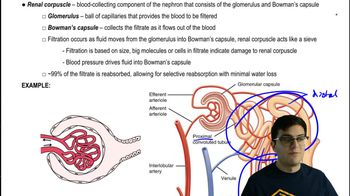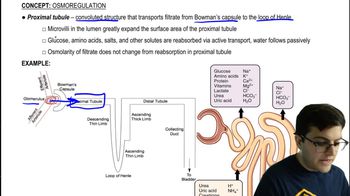Table of contents
- 1. Introduction to Biology2h 40m
- 2. Chemistry3h 40m
- 3. Water1h 26m
- 4. Biomolecules2h 23m
- 5. Cell Components2h 26m
- 6. The Membrane2h 31m
- 7. Energy and Metabolism2h 0m
- 8. Respiration2h 40m
- 9. Photosynthesis2h 49m
- 10. Cell Signaling59m
- 11. Cell Division2h 47m
- 12. Meiosis2h 0m
- 13. Mendelian Genetics4h 41m
- Introduction to Mendel's Experiments7m
- Genotype vs. Phenotype17m
- Punnett Squares13m
- Mendel's Experiments26m
- Mendel's Laws18m
- Monohybrid Crosses16m
- Test Crosses14m
- Dihybrid Crosses20m
- Punnett Square Probability26m
- Incomplete Dominance vs. Codominance20m
- Epistasis7m
- Non-Mendelian Genetics12m
- Pedigrees6m
- Autosomal Inheritance21m
- Sex-Linked Inheritance43m
- X-Inactivation9m
- 14. DNA Synthesis2h 27m
- 15. Gene Expression3h 20m
- 16. Regulation of Expression3h 31m
- Introduction to Regulation of Gene Expression13m
- Prokaryotic Gene Regulation via Operons27m
- The Lac Operon21m
- Glucose's Impact on Lac Operon25m
- The Trp Operon20m
- Review of the Lac Operon & Trp Operon11m
- Introduction to Eukaryotic Gene Regulation9m
- Eukaryotic Chromatin Modifications16m
- Eukaryotic Transcriptional Control22m
- Eukaryotic Post-Transcriptional Regulation28m
- Eukaryotic Post-Translational Regulation13m
- 17. Viruses37m
- 18. Biotechnology2h 58m
- 19. Genomics17m
- 20. Development1h 5m
- 21. Evolution3h 1m
- 22. Evolution of Populations3h 52m
- 23. Speciation1h 37m
- 24. History of Life on Earth2h 6m
- 25. Phylogeny2h 31m
- 26. Prokaryotes4h 59m
- 27. Protists1h 12m
- 28. Plants1h 22m
- 29. Fungi36m
- 30. Overview of Animals34m
- 31. Invertebrates1h 2m
- 32. Vertebrates50m
- 33. Plant Anatomy1h 3m
- 34. Vascular Plant Transport2m
- 35. Soil37m
- 36. Plant Reproduction47m
- 37. Plant Sensation and Response1h 9m
- 38. Animal Form and Function1h 19m
- 39. Digestive System10m
- 40. Circulatory System1h 57m
- 41. Immune System1h 12m
- 42. Osmoregulation and Excretion50m
- 43. Endocrine System4m
- 44. Animal Reproduction2m
- 45. Nervous System55m
- 46. Sensory Systems46m
- 47. Muscle Systems23m
- 48. Ecology3h 11m
- Introduction to Ecology20m
- Biogeography14m
- Earth's Climate Patterns50m
- Introduction to Terrestrial Biomes10m
- Terrestrial Biomes: Near Equator13m
- Terrestrial Biomes: Temperate Regions10m
- Terrestrial Biomes: Northern Regions15m
- Introduction to Aquatic Biomes27m
- Freshwater Aquatic Biomes14m
- Marine Aquatic Biomes13m
- 49. Animal Behavior28m
- 50. Population Ecology3h 41m
- Introduction to Population Ecology28m
- Population Sampling Methods23m
- Life History12m
- Population Demography17m
- Factors Limiting Population Growth14m
- Introduction to Population Growth Models22m
- Linear Population Growth6m
- Exponential Population Growth29m
- Logistic Population Growth32m
- r/K Selection10m
- The Human Population22m
- 51. Community Ecology2h 46m
- Introduction to Community Ecology2m
- Introduction to Community Interactions9m
- Community Interactions: Competition (-/-)38m
- Community Interactions: Exploitation (+/-)23m
- Community Interactions: Mutualism (+/+) & Commensalism (+/0)9m
- Community Structure35m
- Community Dynamics26m
- Geographic Impact on Communities21m
- 52. Ecosystems2h 36m
- 53. Conservation Biology24m
42. Osmoregulation and Excretion
Osmoregulation and Excretion
Problem 14
Textbook Question
Textbook QuestionFish and other aquatic organisms are exposed to many types of water pollutants, including metals such as aluminum. Although a low level of aluminum is found in unpolluted water, many lakes and streams have an increased level because of mining, sewage treatment, and accidental spills of toxic materials. Aluminum pollution can result in mass fish die-offs. The scientists also measured the activity of Na+/K+-ATPase, in the gills of the fish exposed to aluminum and compared it to that of the control fish. What do you suppose were their results? Explain.
 Verified step by step guidance
Verified step by step guidance1
Step 1: Understand the role of Na+/K+-ATPase in fish. Na+/K+-ATPase is an enzyme found in the cell membranes of fish gills that helps maintain osmotic balance and proper ion gradients by pumping sodium (Na+) out of the cells and potassium (K+) into the cells.
Step 2: Recognize the impact of aluminum on fish. Aluminum exposure in aquatic environments can lead to physiological stress in fish, affecting their gill function, which is crucial for respiration and ion regulation.
Step 3: Hypothesize the effect of aluminum on Na+/K+-ATPase activity. Given the toxic nature of aluminum, it is likely that the activity of Na+/K+-ATPase in the gills of fish exposed to aluminum would be reduced. This reduction could impair ion regulation and osmotic balance in the fish.
Step 4: Compare the activity of Na+/K+-ATPase in exposed fish versus control fish. The scientists would measure and compare the enzyme activity levels. It is expected that the fish exposed to aluminum would show lower Na+/K+-ATPase activity compared to the control fish, which were not exposed to aluminum.
Step 5: Analyze the implications of the results. If the hypothesis is correct and there is a decrease in Na+/K+-ATPase activity in aluminum-exposed fish, this could explain physiological disturbances leading to mass die-offs, as the fish would struggle with disrupted ion balance and osmoregulation.
Recommended similar problem, with video answer:
 Verified Solution
Verified SolutionThis video solution was recommended by our tutors as helpful for the problem above
Video duration:
2mPlay a video:
Was this helpful?
Key Concepts
Here are the essential concepts you must grasp in order to answer the question correctly.
Aluminum Toxicity in Aquatic Organisms
Aluminum is a metal that can be toxic to aquatic life, particularly at elevated concentrations. In fish, exposure to high levels of aluminum can disrupt physiological processes, leading to stress and potentially fatal outcomes. This toxicity is often exacerbated in acidic waters, where aluminum becomes more soluble and bioavailable, impacting gill function and overall health.
Recommended video:
Guided course

Introduction to Aquatic Biomes
Na+/K+-ATPase Function
Na+/K+-ATPase is an essential enzyme found in the membranes of cells, including those in fish gills. It plays a critical role in maintaining the electrochemical gradient across the cell membrane by pumping sodium out and potassium into the cell. This process is vital for osmoregulation, nerve impulse transmission, and muscle contraction, making it a key indicator of cellular health and function in response to environmental stressors.
Recommended video:
Guided course

Primary Active Transport: Na+/K+ Pump
Impact of Pollutants on Fish Physiology
Pollutants like aluminum can significantly affect fish physiology, particularly in their gills, which are crucial for respiration and ion regulation. Exposure to such pollutants can lead to altered enzyme activity, impaired gas exchange, and disrupted ion balance. The measurement of Na+/K+-ATPase activity in fish gills serves as a biomarker for assessing the physiological impact of pollutants, indicating how well the fish can cope with environmental stress.
Recommended video:
Guided course

Geographic Impact on Communities

 7:16m
7:16mWatch next
Master Osmoregulation and Nitrogenous Waste with a bite sized video explanation from Jason Amores Sumpter
Start learningRelated Videos
Related Practice



































































